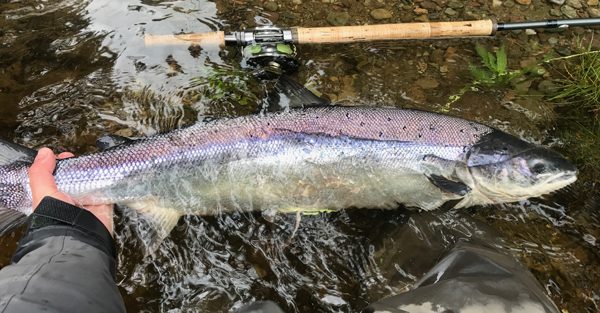 There is definitely a misconception that saltwater flyfishing for Coho, or any salmon for that matter, is non existent! Well much like the moment you buy a computer it becomes obsolete, the idea that flyfishing in the open ocean is not as exciting or productive as freshwater fishing for salmon or trout, is also a thing of the past.
There is definitely a misconception that saltwater flyfishing for Coho, or any salmon for that matter, is non existent! Well much like the moment you buy a computer it becomes obsolete, the idea that flyfishing in the open ocean is not as exciting or productive as freshwater fishing for salmon or trout, is also a thing of the past.
A number of professional anglers and guides have been practicing these saltwater techniques for years, just fine tuning their efforts until the right time to expose the right ones at the right times! Well it???s time! Guides and Charters are now available for excursions that allow for fishing Coho on the fly.
The ocean flyfishing movement started with wet lines and sinking or weighted patterns but much like the popularity of the sport, has evolved into something much bigger and better and seems to ???float to the top??? of every magazine or article that relates to fishing for salmon or steelhead. Well maybe the line isn???t always floating, but compared to the fast sinking lines and Clouser minnows of yesteryear, methods have changed into a slower sinking line or sometimes a completely floating line with ???jumping and hopping??? topwater movements.
As with any change, comes more change! With new developments in the success of topwater or surface flyfishing for Coho and a bucket full of nothing but new ideas, the same old flies needed adjustment to keep up with the technique altering. Experimentation was needed in order to harness the new style of Coho fishing on the fly.
???Oh Where Oh Where Did My Loadie Doe Coho Go????
Locating Coho in the river is one thing! Try finding these silver buggers in their open marine environment! It???s definitely tricky and without the proper tackle and gear, it can be what my brother always called a???WOT??? or waste of time, sometimes ???WOFT.??? If it???s one thing to keep in mind, it???s that in the summer before the fish move to the rivers to spawn, they want one thing and one thing only???food! If you can find the kelp beds that they are moving in and around this will help you find fish.
Coho look for these kelp beds in search of herring that move to these beds for cover and safety. The herring that the Coho are after will be in the top 30 percent of water depending on how deep it is. Now the thing to watch for in these beds is wounded or ill herring that struggle along the surface in a circular motion and make a tiny little wake behind them in the shape of a ???V.??? These are good signs for the Coho fisherman that???s looking for these salmon because the Coho love to buzz across these kelp lines looking for the struggling ???V.??? There???s nothing better than finding the Coho as they circle the herring like a pack of sharks ready to kill, as they splash, jump and fight aggressively over their next meal.
The kelp acts as a great way for the herring to hide or find protection against Coho and other salmon looking to fatten up and the Coho seem to know it. Much like in a river system where a Steelhead will sit behind a rock or log jamb for the current to push an earthworm right in front of him, the Coho can sometimes be found while sitting along the line of a kelp bed waiting for an un-suspecting herring to be pulled out into the open by the tide before getting smashed by half a dozen Coho.
Being prepared for the fight
Just like you should get all your ducks in a row before heading out on the river for an early first light Coho fish, you need to make sure you???re prepared for what???s in store on the ocean???even more so with the danger of the ocean. Have all of your spey fishing tackle cleaned, ready to go and organized so you don’t miss anything, cuz it’s a long trip back for a couple of 5 dollar flies!
Assuming you are someone experienced on the waters or with someone who knows how to navigate the ocean with lots of respect, there are a couple of things that you will need to do once you have found the Coho kelp beds with ???rising??? Coho on the perimeter. These are the steps that I would suggest you take before throwing a line into the water. Remember that once you???ve found Coho feeding, if you???ve taken all of these steps and followed them to a tee, you???ll be surprised at how quickly a couple of quick strips back with your fly after you???ve casted, it will take for your fly to be absolutely attacked by an aggressive Coho.
- Observe – look for rising fish and guestimate the underwater kelp environment.
- Observe Wind ??? position yourself correctly against the wind.
- Observe Current ??? position yourself correctly against the current.
- Stealth ??? be quiet! Be stealthy and try not to hit the boat with anything.
- Anchor ??? anchor yourself in the correct position quietly, taking into consideration all of the things that you have watched such as fish, wind and currents.
- Observe Fish ??? watch patiently for rising or jumping fish either herring OR Coho.
- Fly ??? after choosing the right coho fly make sure to have your fly rod and reel ready to go for the next jumper.
Fish On!!!
When fishing Coho on the fly there are a couple of things out of the norm from fishing in a river or downrigging. One technique that is recommended when fishing Coho like mentioned above is once a fish is on, or thought to be on, you should always give the line a couple more strips before the set.
Often the fish will attack the fly in increasingly strong waves of aggression. If you set the hook to soon you are apt to pull the hook away from the feed and miss the fish ??? a couple of quick strips back after a nibble will ensure that the fish keeps attacking the line until they literally hook themselves.

